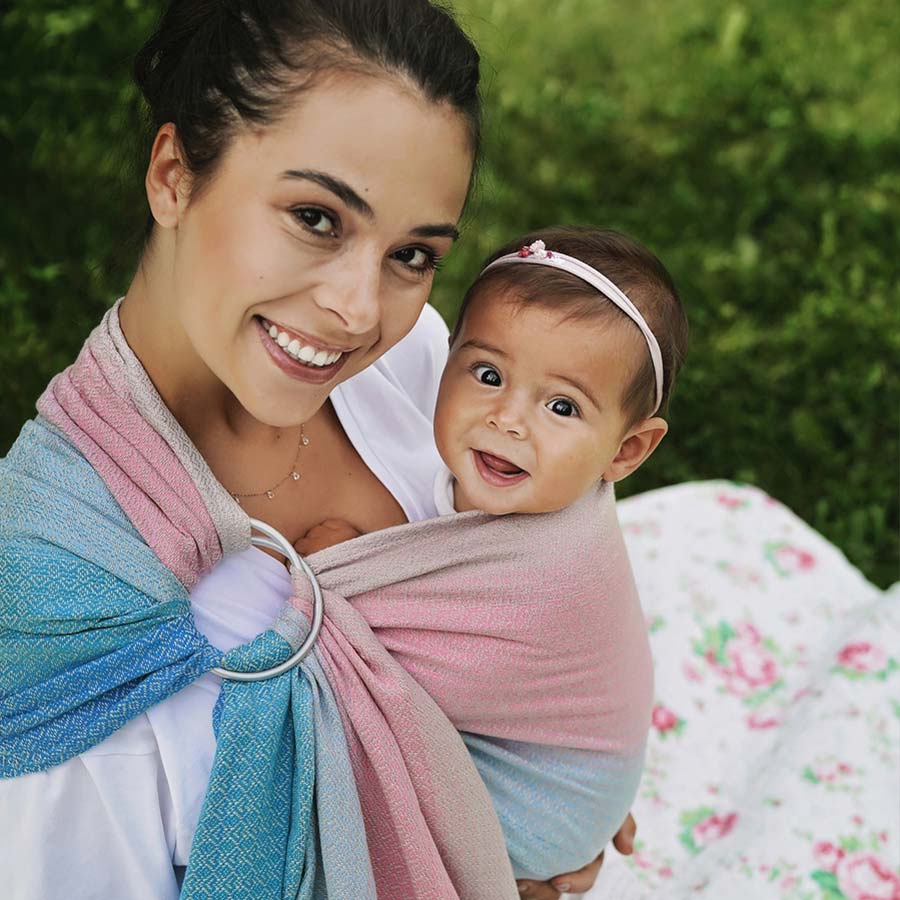
Ring slings are awesome; we absolutely love them! A ring sling comprises a long piece of woven wrap fabric with 2 aluminium rings sewn into one end. The length usually ranges from 1.7m to 2m. The tail (end of the woven wrap) is usually asymmetric.
A ring sling is a baby carrier that is a wonderful option for the fourth trimester, newborn days and beyond. A single layer carry, without fuss, they are light, easy to care for and can be used way beyond the fourth trimester. Ring slings offer a single layer carry, so there's less fuss, less fabric (when compared to a woven wrap, for example), less effort to get baby in the sling and secure. It's a lighter sling for you and for baby, and from a sensory perspective, there’s less bulk, less sling. As they are lighter, they tend to dry very quickly, so are ideal for washing and drying quickly.
Ring slings are fantastic, and once you get the hang of them they are one of the easiest and quickest types of sling to use. With just a few pro-tips, you’ll find out just how awesome they are. Once you’ve threaded the ring sling and you have it in place, here is how to use a ring sling:
- adjust the fabric through the rings using the fabric in the tail that sits closest to your arm; this will make the section under baby’s bottom a little tighter, to help achieve a nice deep seat;
- move the rings a little high on your body (they will move down a little as you adjust it);
- welcome baby onto your empty shoulder;
- place your free hand (the one on the same side as the rings) against your chest and pull the fabric of the sling away from your body to allow you to welcome baby’s feet and legs inside the pouch;
- use the pouch to set the seat - some call it a perch, a rope, or a band - use it by setting it behind baby's knees, in a straight line from one knee to the other; this will help create that nice deep seat that you want;
- only walk just enough fabric up baby’s back, i.e. only just enough to the nape of baby's neck;
- when adjusting the fabric (either up baby's back or through the rings), always try to lift baby's weight - imagine you're doing the robot dance - your arm is bent at the elbow so that your forearm is in a horizontal line and parallel with baby's bottom. Supporting baby in this way will ease the pressure of the fabric in the rings of the sling, allowing it to be more easily adjusted;
- work any excess fabric from around your back towards the rings;
- adjust the excess fabric through the rings in a horizontal motion - going in the direction the fabric has come from. The fabric will move through the rings with much greater ease.
Practicing these steps will help you become a ring sling pro!
Ring slings are a fantastic, easy to use option, particularly great for newborns and toddlers at the up-and-down-stage. They are a different type of carrier when compared to buckle carriers such as the BabyBjorn Carriers, but they are easy to put on, easy to take off, and can stay threaded in between uses and left over your shoulder or popped in your bag, and re-used again when needed.
Happy ring slinging!
 5,467 Reviews
5,467 Reviews